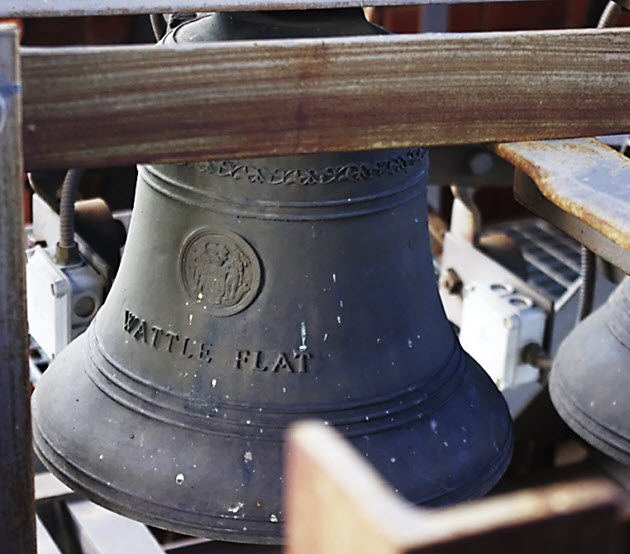
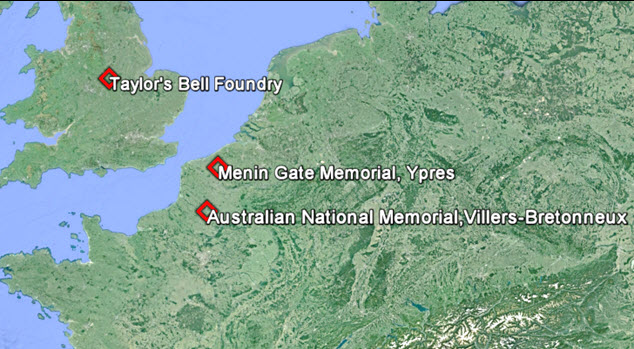
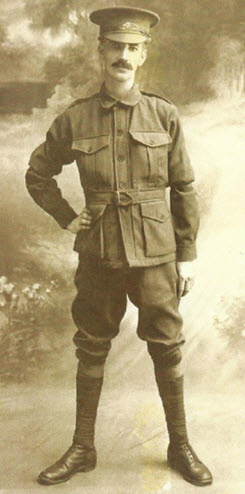
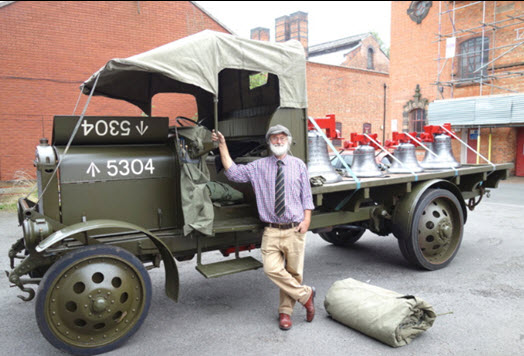
Clockwise from Top Left :
- (A)The Wattle Flat bell cast in 1929 in the Bathurst Carillion;
- (B) Private Henry George Foster (Royal Hotel, W. Flat), died on the battle ground in 1918;
- (C) 2017 delivery of new bells in WWI truck from Taylors Bell Foundry to Ypres;
- (D) Location Map ( Foundry, Ypres & Australian National Memorial).
Bathurst War Memorial Carillion
Triggered by current refurbishments of the Bathurst War Memorial Carillion, research into the history & meaning of the Wattle Flat bell in the Carillion were initiated. This also follows up comment on this subject by E Buscombe in last issue of this newsletter.
The concept of Bathurst Carillion as a memorial to our service men who engaged in WWI was conceived in 1926. A 30m high brick tower with a peal of 35 bells was constructed & opened in 1933, to a crowd of about 15,000 people. Funds were raised largely by the local communities using events including the Bathurst Belle Competition in 1927, and the Miss Bathurst Competition in 1929. Don Bradman was invited for a fund raising cricket match in 1931. A “Back to Bathurst Week” in 1933 was also used during which it was stated that: 2d purchases & places one brick; & £8 purchases & places 1000 bricks. The tower was made from 212,000 locally made bricks. The 35 bells were cast in England by Taylor & Co in 1928 & delivered in 1929.
In 1933, at the opening it was suggested that all cards & ribbons from wreaths hung at the Carillion could be burnt, and that the ashes could be sent to France for distribution over a proposed Australian National War Memorial there.
Of the 35 bells installed in the Carillion the largest weighs 1.6 tonnes & the smallest just 8 kgs. Most of the bells bear inscriptions. The largest bell reads “Thus Bathurst and her surrounding villages honor their men of 1914-1918. Lest we forget”. The 2nd largest reads “To the ever glorious memory of our fallen comrades. Greater love has no man than this that he laid down his life for his friends”. The 3rd features the Red Cross emblem in honor of war nurses.
Twenty nine of the small bells bear inscriptions of the name of the smaller communities surrounding Bathurst. Wattle Flat is one of these, and Wattle Flat, the community, certainly gave a lot as part of Australia’s contribution in allied fighting in WWI.
The Wattle Flat WWI Honor Board – located in the Wattle Flat Public School
Of 38 WWI enlistees with close links to Wattle Flat, 10 lost their lives.
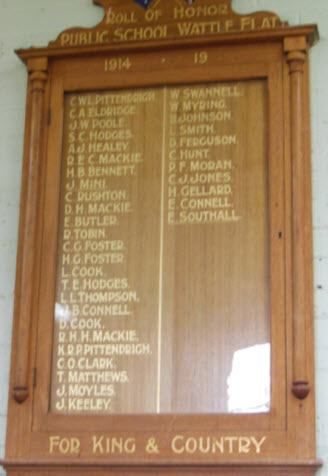
In researching those who enlisted at Wattle Flat, the first port of call was Wattle Flat’s WWI Roll of Honour board displayed in the Wattle Flat Public School shown here.
Follow up research using the AIF (Australian Imperial Force) website https://aif.adfa.edu.au suggests that some amendments & additions to this list maybe warrented. See Table below.
Additional research draws on family histories & military records accessed through “Ancestry.com”.
The following table summarises this work. It is not exhaustive and it reveals numerous as yet unanswered questions. This table is of WWI enlistees who were either born in Wattle Flat or have had very strong connections to Wattle Flat prior to enlistment. This list broadly matches the Honor board in Wattle Flat Public School but has some variations. Please accept my apologies in advance for any inadvertent omissions or errors.
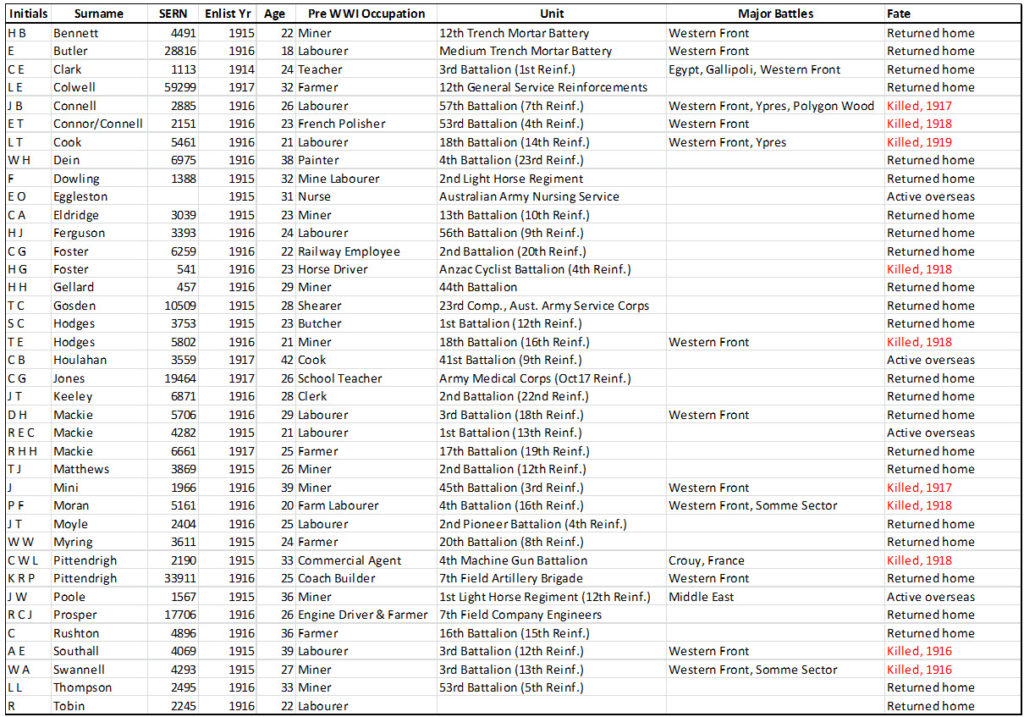
Four soldiers on this list received special recognition for bravery & devotion to duty :
Herbert Bright Bennett received the Military Medal :
- ‘For his devotion to duty and splendid example set to his men during the attack West of BELLENGLISE on the 18th September, 1918. He advanced in face of heavy machine gun fire in support of Infantry who were held up and brought his mortar into action firing on and silencing an active enemy machine gun, thereby enabling the Infantry to push forward.’ Source: ‘Commonwealth Gazette’ No. 115, Date: 10 October 1919
Cecil Olbers Clark received the Military Cross :
- ‘For conspicuous gallantry and devotion to duty when in charge of a patrol. He was suddenly challenged by two of the enemy with fixed bayonets, at a few feet distance, and having no time to draw his revolver, he hit the nearest on the head, with his stick, and took them both prisoners, and brought them into our lines.’ Source: ‘Commonwealth Gazette’ No. 95 , Date: 27 June 1918
Herbert Hilton Gellard received the Military Medal :
- ‘For conspicuous courage and devotion to duty. On night 25th/26th May, 1918, near VILLERS BRETONNEUX, this N.C.O. was in charge of transport carrying barb wire and rations to front line troops. The roads were all heavily shelled with H.E. and gas. As we had advanced our line wire was urgently needed forward. This N.C.O. by his grit and determination succeeded in getting the stores up to the line without sustaining any casualties to men or horses. He set a splendid example of devotion to duty and disregard of personal safety, to his comrades.’ Source: ‘Commonwealth Gazette’ No. 23, Date: 12 February 1919
James Williamson Poole received the Military Medal :
- ‘After an attack on an enemy column retiring from LUDD on 15th November, 1917, this N.C.O. was informed that an Officer had been wounded and was lying under heavy machine gun and artillery fire. He immediately went to the Officer’s assistance dressed his wounds and assisted to carry him for a distance of two miles across an open plain under extremely heavy shell fire. His coolness and daring set a splendid example to all other ranks.’ Source: ‘Commonwealth Gazette’ No. 120, Date: 7 August 1918M
Amongst the strongest community memorials to the WWI gallantry & sacrifice of our Wattle Flat community forebears are the Roll of Honour board and the Wattle Flat Bell. It is understood that Taylor & Co are currently commissioned to re-cast several of the bells including the Wattle Flat bell using its original mould.
In the bell casting & recasting endeavour we are in highly esteemed company. John Taylor & Co – Bell foundry in Leicestershire, England was initiated in 1859 by John Taylor (1827-1906, master bell founder, innovator & philanthropist. The company mission phase is – “Resounding around the world for all to hear.” (see website http://www.taylorbells.co.uk )
Notable Bells produced by John Taylor & Co:
- 1881: The “Great Paul” bell, (the largest bell cast in Britain) for St Paul’s Cathedral weighing 17 tonnes.
- 1890: Bells for the Sydney GPO, clock tower.
- 1970: National Carillion, Canberra. A gift from the British Government
2017: New set of bells for Ypres (see figure at top), near the site of the battles that our service men fought in.
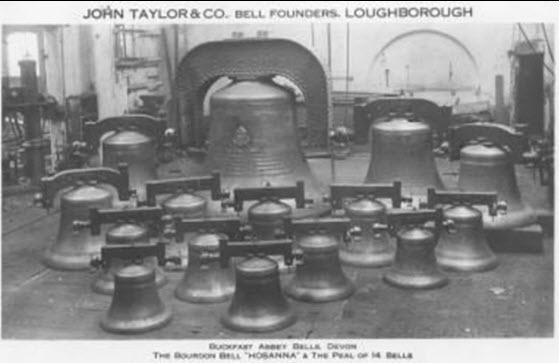
A peal of 14 Bells founded in 1936 for Buckfast Abbey (Devon) by John Taylor & Company, England.
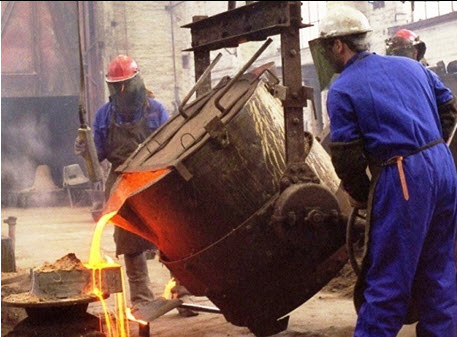
Modern Bell casting by John Taylor & Co. c2017